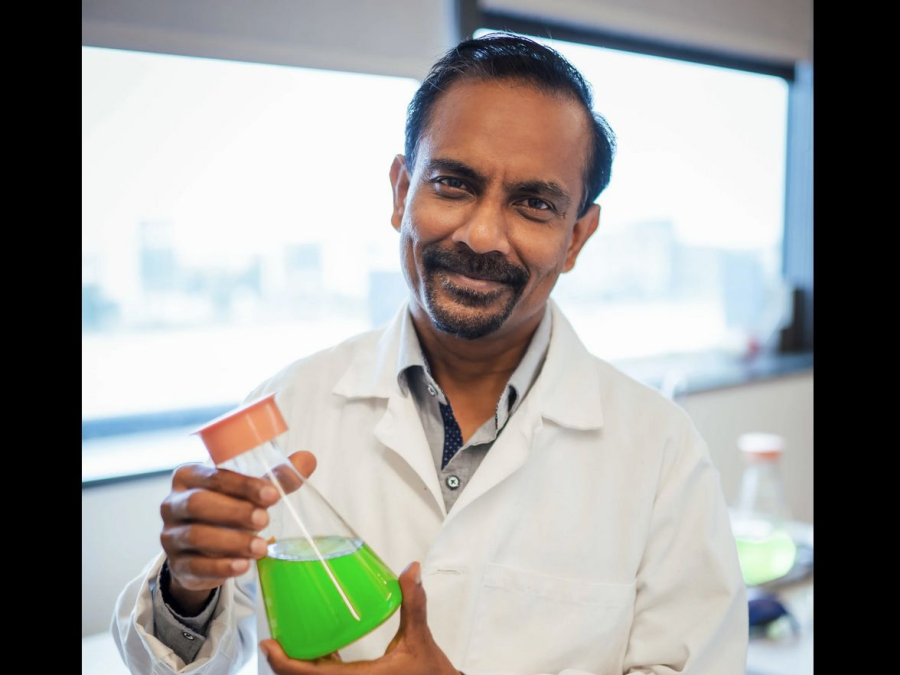Unlocking Potential
Venkatesh Balan sees a climate hero in an unlikely little creature: microalgae that have proven remarkably effective at removing carbon dioxide from the atmosphere.
In the Microbiome and Genomics Lab at the University of Houston at Sugar Land, Venkatesh Balan produces a glass flask containing a putrid green liquid. The contents resemble the aftermath of a clogged sink, but Balan believes it could be a secret weapon in the fight against climate change.
The cloudy mixture contains a culture of microalgae — millions of microscopic phototropic organisms that, like plants, pull carbon dioxide out of the air and release oxygen. In recent years, Balan and other researchers have developed new ways to put these little creatures to work at an industrial scale.
Balan, an associate professor of biotechnology in UH’s Cullen College of Engineering’s Technology Division, spent his career researching industrial applications of microbiomes. His research focused on how microbiomes, through the process of biomass conversion and fermentation, can be used to produce ethanol and organic acids used in various chemical products. After arriving at UH in 2017, he decided to shift his attention to the planet.
“The biggest threat of the world is global warming, climate change, carbon emissions,” Balan says. “So, I starting thinking, ‘Why don’t we use our same knowledge on fermentation and bio- mass conversion in a different area?’ So, I started working on algae.”
THE POWER OF CONVERSION
Researchers and corporations have been exploring methods to remove carbon dioxide from the atmosphere for years. The most popular mitigation strategies involve direct air capture — industrial-sized plants which can “scrub” carbon dioxide out of the air and pump into large storage reservoirs underground. The problem, Balan argues, is that these methods are energy intensive and expensive, and they don’t adequately account for the long-range storage of recaptured CO2.
“We are thinking about the next 50 years,” he said. “But we’re not thinking about beyond 50 years.”
Algae, on the other hand, doesn’t require solving for storage of captured carbon. In fact, algae removes carbon by processing it into other compounds — carbohydrates, lipids and proteins — that can be used to make other useful products like biofuel and fertilizer, thus helping to reduce the carbon emissions of those industries.
“We are working on technologies to capture the CO2 using algae that has 90 percent efficiency,” Balan said. “The bioproducts produced by processing algae could displace fossil fuel and satisfy growing bioproducts needs.”
THE ORIGINAL GREEN SOLUTION
If you are wondering how a microscopic organism could possibly play a role in the fight against a global challenge, Balan urges a close look at the history of the Earth’s atmosphere. Hundreds of millions of years ago, the atmosphere mostly consisted of carbon. Then came the algae. Massive ancient blooms of algae in the prehistoric oceans kick-started a process of oxygenating the atmosphere, changing the trajectory of the emergence of life on earth.
“Algae has been doing this for millions of years,” Balan said. “So, why don’t we use algae to our advantage and make it much more sustainable?”
The challenge, however, is figuring out how to make algae-driven carbon capture scalable. Scientists have been experimenting with methods of cultivating algae for biomass conversion and fermentation for several years. But their methods are expensive, which has kept algae production commercially viable only for use in high-value products like biofuels or ingredients used in pharmaceuticals.
ALGAE: POWERFUL AND ADAPTABLE
Balan believes his cultivation method could be deployed at a greater scale. Rotating Algal Biofilm (RAB) grows algae on a “biofilm” that circulates in a vat of water. These machines resemble an upturned treadmill submerged in sludgy water with algae growing on the spinning band. The advantage to this cultivation method is that it is relatively cheap and simplifies the harvesting of the algae to simply scraping the algae from the biofilm. Another advantage is that RABs can be incorporated into existing systems that are already working with processing water, like wastewater treatment facilities.
Balan conducted a study that evaluates how much algae could be grown if RAB reactors were installed at Texas’ three largest wastewater treatment facilities. The results show the potential of scaling algae production by retrofitting wastewater treatment plants with RABs to cut down on the overhead costs of the cultivation. The algae clean wastewater and sequester carbon. And the natural bioproducts produced through algae biomass conversion can be used to create more eco-friendly versions of products like fertilizer, animal feed, biofuels and bioplastics.
NEXT STEPS: CULTIVATING COLLABORATION
Balan is now collaborating with a company in Iowa on a U.S. Department of Energy-funded project that uses an RAB algae cultivation system at a wastewater treatment plant, which will both sequester carbon and create biomass fertilizers for Iowa farmers.
The challenge is convincing investors and policymakers to support the solution. The largest investments into carbon sequestration strategies have been in the direct air “scrubbing” and storage technologies, largely because the oil and gas companies that are investing heavily in the technology are heavily subsidized by the federal government. Balan hopes his research can help push government regulators to see the potential of investing in a “greener” form of greenhouse gas emissions capture.
“If the government plays a role, they can drive it much faster,” he said.
